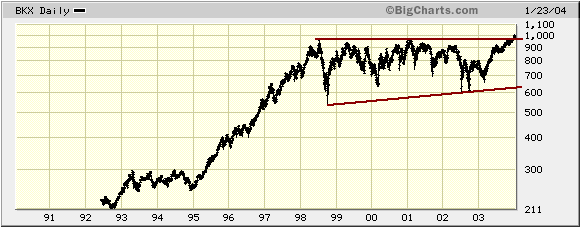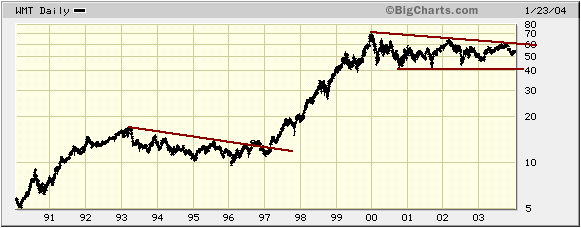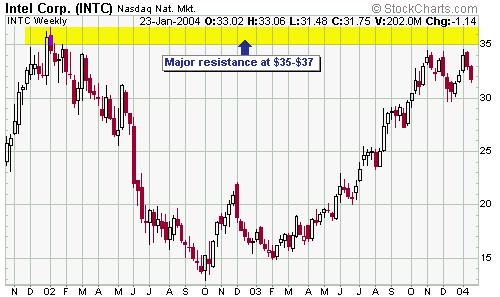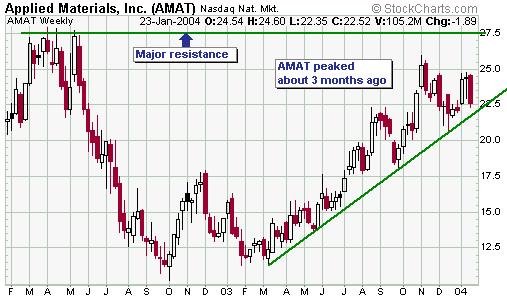|
-- Weekly Market Update for the Week Commencing 26th January 2004
Big Picture
View (Most recent update: 12 January 2004)
Here is a summary of our big picture
view of the markets. Note that our short-term views may differ from our
big picture view.
Bond yields (long-term interest
rates) bottomed in June of 2003 and will move considerably higher during
2004 and 2005.
The stock market rally that
began in October of 2002 will end during the first half of 2004. The October-2002
bottom will be tested during 2005.
The Dollar will make an intermediate-term
bottom during the first half of 2004 in the vicinity of its 1995 low and
then rally for at least 6 months, but a long-term bottom won't occur until
2008-2010.
Gold will make an intermediate-term
peak during the first half of 2004 and then consolidate for at least 6
months, but a long-term peak won't occur until 2008-2010.
Commodities, as represented
by the CRB Index, will make an intermediate-term peak during the first
half of 2004 and then consolidate for at least 6 months, but a long-term
peak won't occur until 2008-2010.
Copyright
Reminder
The commentaries that appear at TSI
may not be distributed, in full or in part, without our written permission.
In particular, please note that the posting of extracts from TSI commentaries
at other web sites or providing links to TSI commentaries at other web
sites (for example, at discussion boards) without our written permission
is prohibited.
We reserve the right to immediately
terminate the subscription of any TSI subscriber who distributes the TSI
commentaries without our written permission.
The price-fixers
get together again this week
The Federal Open Market Committee (FOMC)
gets together this week to decide what the price of short-term money should
be. There will obviously be no change in the Fed Funds Rate as a result
of this meeting, but our forecast has been that the January meeting would
be the one at which the Fed would move to a 'tightening bias'. In other
words, we've forecast that the FOMC's next post-meeting statement on monetary
policy would talk about the risks being skewed towards higher inflation.
However, we no longer think there will
be a significant change in the way this week's monetary policy statement
will be worded because, from the Fed's distorted perspective of the world,
there does not appear to be any reason to make a change. In particular,
T-Bond futures are close to a 6-month high despite Friday's potentially-important
downward reversal and the CPI is showing almost no signs of life. Having
done such a good job over the decades of convincing most people that the
CPI is a measure of inflation and that a rampant expansion of credit (which
is continuing, by the way, despite the pullback in the monetary aggregates)
is not a problem unless it causes the CPI to rise, the Fed is now in a
position where it could not justify making any change to its stance.
Japan is
supporting the US bond market, but not much else
Over the past year the Bank of Japan
(BOJ), acting on behalf of the Japanese Ministry of Finance, purchased
about 200 billion US dollars in its attempts to prevent the Yen from appreciating
against the US$. And almost all of the dollars purchased during these currency-market
interventions were invested in US Government debt.
Now, the BOJ's currency management
efforts have not exactly been a resounding success because the Yen has
strengthened considerably against the US$ over the past year. It could,
perhaps, be argued that without this intervention the US$ would be even
weaker, and this might be true. However, as long as the Japanese keep buying
US bonds with the dollars they purchase in their efforts to manage the
Yen-Dollar exchange rate the results of their interventions will be muted
as far as the currency market is concerned. This is because they are not
reducing the supply of dollars; they are, instead, re-cycling dollars (the
dollars are being returned to the market in exchange for US Treasury debt).
The intervention would likely be much more effective if the dollars were
retained by the BOJ.
The greatest effect of Japan's attempts
to support the US$ has been evident in the US bond market. This is not
only due to the direct effect of Japanese buying on US bond prices, but
the fact that massive Japanese buying of US bonds puts downward pressure
on long-term interest rates; and the relatively-low level of US interest
rates helps to weaken the US$.
The US
Stock Market
Don't get hung-up on the "bull"
and "bear" labels
In June of last year (refer to http://www.gold-eagle.com/editorials_03/milhouse062103.html)
we began to seriously consider the possibility that a bear market had not
yet begun in the US stock market. Instead, we said that the stock-market
action of 2000-2002 might have simply removed relative excesses within
the market and that a bona fide bear market lay in the future, not the
past.
Clearly, the NASDAQ has experienced
a bear market of historic proportions and, given the extremely high valuations
of many NASDAQ stocks, the bear market is not over. In other words, the
NASDAQ's rally over the past 15 months is most likely a very powerful rebound
within a secular bear trend. However, many important sectors of the market
have moved to new all-time highs over the past 6 months and are clearly
not immersed in bear trends. For example, the Philadelphia Bank
Index, the MS Cyclical Index, the MS Index of Commodity-Related Stocks,
the S&P Retailing Index and the S&P Homebuilding Index are at,
or near, all-time highs. In the case of the Bank Index (see chart below),
the recent upside breakout from a 6-year consolidation range might turn
out to be a 'bull trap' of similar nature to the Dow's move to a new high
in January of 1973. At this time, though, the technical evidence does not
indicate that a bear market is in progress.

There is also scant evidence of any
bear trend in the below chart of Walmart (NYSE: WMT), the world's largest
company in terms of both sales volume and number of employees. Rather,
it looks like WMT has been consolidating over the past few years in a similar
vein to its 1993-1996 consolidation.

What the post-October-2002 market should
not be labeled, in our opinion, is a NEW bull market. In some sectors of
the market the old bull market never ended whereas in other sectors there
have been sizeable bear-market rallies. In any case, labels such as "bull"
and "bear" are rarely of any practical use because a 50% profit achieved
during a bear-market rally is just as good as a 50% profit achieved during
a bull market. Perhaps the only relevance is that long-term investors who
purchase stock during a secular bull market will probably get bailed out
by the market's upward trend if they are prepared to hold for long enough,
even if their purchases were ill-timed. However, the opposite is true in
a secular bear market.
As an aside, one thing that has the
potential to precipitate a general bear market in US stocks is a breakdown
in the bond market (higher interest rates). Once bonds break below their
August-2003 lows it will be difficult to justify owning ANY stocks.
Current Market Situation
Below are weekly charts of Intel (NASDAQ:
INTC) and Applied Materials (NASDAQ: AMAT), the world's largest semiconductor
company and the world's largest semiconductor equipment company, respectively.
These two bellwether stocks haven't participated in the upward move that
has occurred in the broad market since early-November, a possible bearish
divergence. AMAT, in particular, has been quite soggy and is a stock we'll
be watching closely over the coming weeks.


The Dow and the NASDAQ dropped last
week, ending their respective winning streaks at 8 weeks and 6 weeks. The
S&P500, however, has now risen for an incredible nine weeks in a row.
A pullback probably began at last week's
highs, but we wouldn't be surprised to see a re-test of the highs this
week before corrective action becomes a bit more pronounced. The FOMC Meeting
should provide some support to the market during the second half of the
week assuming the Fed makes no changes to its monetary policy statement,
as should the buying that typically emerges during the last few days of
each month.
This week's important economic events
| Date |
Description |
| Monday Jan 26 |
Existing Home Sales |
| Tuesday Jan 27 |
Consumer Confidence |
| Wednesday Jan 28 |
FOMC Meeting
Durable Goods Orders
New Home Sales |
| Thursday Jan 29 |
Employment Cost Index |
| Friday Jan 30 |
Q4 GDP (pre-lim) |
 Click
here to read the rest of today's commentary Click
here to read the rest of today's commentary

|

